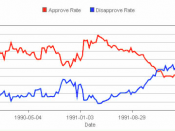For more than a decade, the quantification of utility loss resulting from increased hiring of members of lower performing groups has become an issue for both researchers and policymakers concerned with selection fairness. Because the job performance of minority hires is typically found to be, on average, lower than the job performance of majority hires (Bernardin, 1984; Campbell, Crooks, Mahoney, & Rock, 1973; Ford, Kraiger, & Schechtman, 1986; Gael & Grant, 1972; Gael, Grant, & Ritchie, 1975), our focus is on the impact of increased minority hiring on job performance. Specifically, this article examines the performance loss resulting from hiring minority applicants at a rate in excess of that recommended by a valid, top-down, single-list procedure (i.e., fair according to the Cleary, 1968, definition). This may occur when organizations attempt to increase the group's representation within the work force or when organizations are forced by the courts to hire minorities at applicant representative rates, or even at rates in excess of the minority representation, to compensate for past discriminatory organizational behavior (e.g.,
Arnold v. Ballard, 1975; Commonwealth of Pennsylvania v. O'Neill, 1972).
Our objectives do not include arguing for or against increased minority hiring. Obviously an organization needs to consider other factors beyond the impact on performance when addressing this issue. Other factors include the benefit to the minority group, indirect benefits of a diversified perspective that cultural diversity provides, and costs associated with litigation of unfair discrimination lawsuits. These and other factors may, ultimately, outweigh the importance of performance. However, the cost of performance is an important facet and should be explicitly quantified and integrated with other information in deciding on the appropriate level of minority hiring.
Previous ResearchPrevious research has addressed the impact of increased minority hiring on performance. The earliest research restricted itself to available selection fairness...


